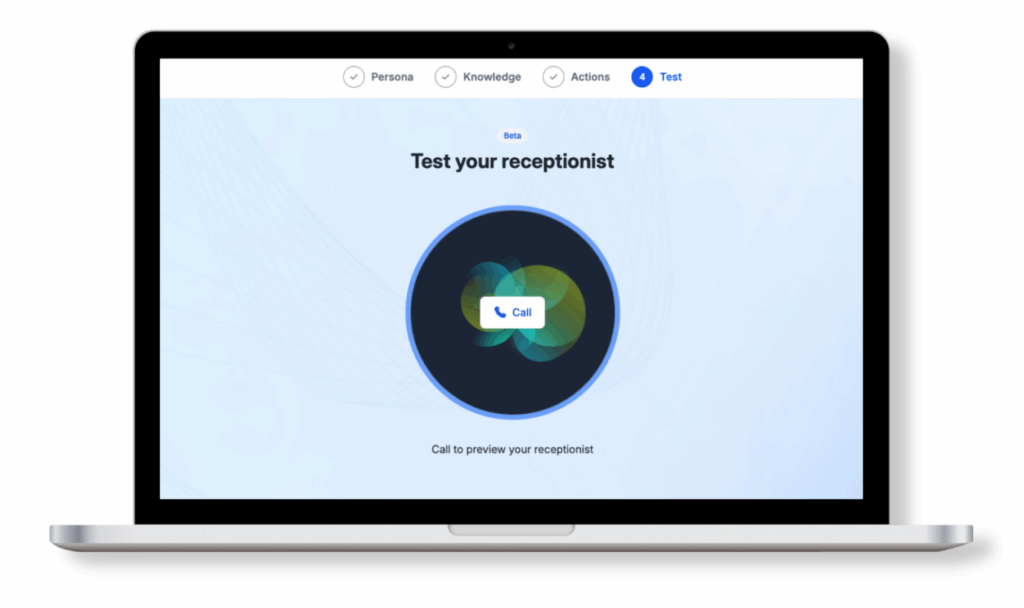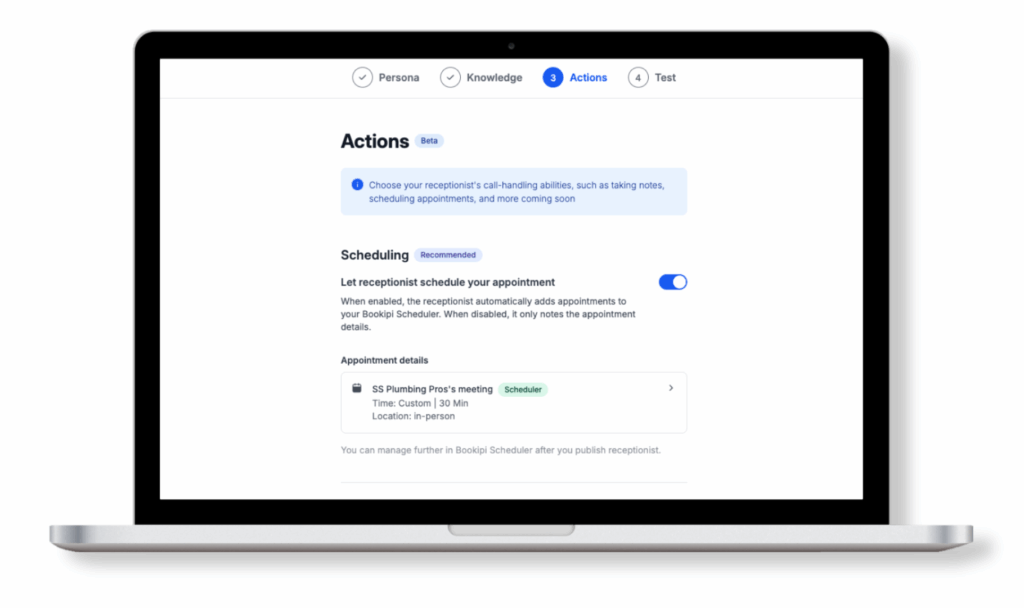Imagine having the ability to address more customer support inquiries without the added time, cost and effort. With customers expecting immediate and accurate responses more than ever, small businesses that meet these expectations with automated customer service stand out from their competitors and boost customer retention.
Automation has been quietly reshaping customer service by making it faster, more consistent, and way more scalable. Gartner predicts that automation tools like AI can resolve 80% of customer service issues without human interaction by 2029. This shift isn’t just for big corporate organizations. Automated and AI-driven customer service helps small businesses respond quicker, save on staffing costs, and never miss a beat, even during busy hours or off-times.
What is customer service automation?
The automated customer service definition is using technology like AI, chatbots, and other tools to handle everyday support tasks without needing a human every time. Whether it’s answering FAQs, booking appointments, or sending instant messages, customer service automation takes repetitive work off your plate so you and your team can focus on more complex tasks that require a human touch.
We’ve seen small businesses that went from spending hours a day on customer support to just 15 minutes, just by setting up automated answers for their most common questions.
How does automated customer service differ from traditional customer support?
Traditional support usually means a human jumps into every conversation, whether it’s someone asking what time you open or someone with a complicated issue that needs hands-on attention.
With automated support, smart systems handle the low-effort, high-volume tasks. This doesn’t mean replacing your team. It means helping them be more efficient by letting them do more and be faster without burnout.
- Traditional: Manual replies via email, phone, or chat
- Automated: Instant replies via AI Receptionists, AI chatbots, self-service portals, and pre-configured workflows
What kind of tasks can customer service automation handle?
There are many task examples that customer support automation can handle. Some that are more nuanced and unique to individual businesses, and others that are universally experienced:
- Answering common FAQs (like “Do you ship internationally?” or “What’s your return policy?” or “Do you take walk-ins?”)
- Scheduling appointments or demos without back-and-forth emails
- Taking orders, especially for services with fixed pricing or menus
- Capturing leads and routing them to the right person or department
- Providing status updates (like “Where’s my order?” or “Is my invoice ready?”)
All this happens in real-time, which means no more letting emails pile up overnight or assigning a full-time person to answer repeat questions.
Who and what is automated services for?
This isn’t just for big corporations with giant call centers. Automation in customer service can be accessible and beneficial for small businesses too.
- Freelancers: Auto-reply to inquiries so clients get answers, even while you’re heads down on a project
- Small businesses: Instant responses to common phone inquiries
- Retail & eCommerce: Automate order confirmations, tracking info, and returns
- Professional services: Schedule calls, manage client FAQs, or onboard new customers with workflows
What are the advantages of automated customer service?
Here’s what you get when you automate customer support smarter:
- Faster response times: Instant answers keep customers from exploring your competitors
- 24/7 availability: Your business keeps supporting, even when you’re sleeping, on a job, or off the grid
- Lower costs: Salesforce reports that 9 out of 10 businesses using AI say it allows them to save money and time. Using AI for automated customer support handles more volume without forcing you to hire more headcount before you’re equipped to manage it.
- Fewer errors: Pre-written replies mean less chance of typos or sending the wrong link
- Happier customers: Khoros reports that 83% of consumers feel more loyal to brands that respond to and resolve their complaints. Quick answers and consistent service build trust over time.
- More time for real problems: Let your team handle VIP clients or tricky cases instead of repeating canned answers all day.
The goal isn’t to replace people. It’s to help you and your team support more customers with fewer late nights and less mental overload. And that’s where automation customer service makes all the difference.
How to automate customer service for your business

If you’re wondering how to automate customer support for your business, here’s the short version: start small, be specific, and link it all together. At Bookipi, our tools, like AI Receptionist, are designed to help solo founders and small teams launch AI-powered tools in days, not months, because done right, automation keeps your inbox clear and your people happy.
Start by defining your customer journey
Before implementing customer service and support automation, map out the touchpoints customers have with your business. Where do questions spike? When are people frustrated? What information do they usually want?
- List all the possible channels your customers reach you through. This could be email, chat, socials, contact forms.
- Look at the journey from first visit to post-sale and trace the moments where support is needed.
- Pinpoint which moments are repeatable, scripted, or predictable. That’s your goldmine for automation.
Pick one high-volume task to automate first
You don’t need to solve everything at once. Start with a single use case that drains your time but doesn’t need human touch or decision-making. You’ll get results faster and build confidence.
- Think FAQs: types of services, refund policies, payment issues, account access.
- Recurring admin: appointment bookings, invoice resends, pricing info.
- Status updates: shipping notifications, project progress, onboarding steps.
Find the right automation opportunity
Don’t automate for the sake of it. Ask: what task keeps popping up that people expect super accurate answers to, but don’t need a personalized touch?
- Use analytics and message tagging tools if you’ve got them. Otherwise, review support logs manually.
- Look for trends: A question asked 50 different ways is a prime candidate for a knowledge base article or chatbot flow.
Connect your customer support automation tools to your existing tools
While there are automation tools that can act independently, there are others where you can experience its full potential once connected with your existing tools such as your CRM, inbox, payment tools or knowledge base. Otherwise, you’ll create more work, not less.
- Link up platforms through native integrations or tools like Zapier, Make, or API if you’re technical.
- Route chatbot data into your CRM to give your team context if a human needs to jump in.
- Keep things centralized so you’re not flipping between five dashboards just to update a single customer record.
This is why the Bookipi Product Suite can be accessed with one login, from invoicing, CRM, scheduler to an AI Receptionist, which can also be integrated with universally used external tools such as Google Calendar.
Test your automation flows before they go live
Customer experience is everything. Don’t let a typo or confusing chatbot flow ruin it. Before you automate customer service, always test before publishing live.
- Write clear, calm, human-sounding copy for your bot or automation emails.
- Test flows on mobile and desktop. Your customers won’t sit behind a laptop to chase a refund.
- Try edge cases. What happens if someone says, “I need help ASAP” or types random characters?
One thing I always recommend: have a way out. Let customers opt to talk to a real human easily. Otherwise, you’re just creating a wall, not support.
Keep monitoring and improving your automations
Here’s your reality check: your first version won’t be perfect. That’s normal. What matters is what you do after launch.
- Track things like average response time, customer satisfaction scores (CSAT), and handover rates to human agents.
- Watch where people drop off in chatbot flows or bounce from emails without clicking.
- Use AI tools or auto-tagging to analyze tone, keywords, and unresolved tickets.
Automation isn’t a “set and forget” deal. It’s a loop. Optimize, tweak, test. Repeat. That’s exactly how we’ve managed to scale Bookipi’s support globally.
If you’re still wondering what automated customer service is and how to automate it for your business, the answer lies here: start where it hurts most, test quickly, and integrate smartly. Your support isn’t about being perfect. It’s about being fast, clear, and consistent. Automations just help you scale that without burning out.
5 automated customer service examples
Want to know exactly what customer service automation looks like in practice? Here are five real-life automated customer service examples that small business owners and freelancers are using right now to take pressure off, provide fast responses, and keep their clients happy, 24/7. If you’ve ever lost hours replying to emails or rescheduling appointments manually, you’ll want to look into these.
1. AI receptionists that handle every call, FAQ, and appointment

I’ve seen firsthand how AI Receptionists are game changers for solo business owners and service providers. In fact, one of our Bookipi users has saved over 133 minutes in calls by letting our AI Receptionist handle over 230 calls for them. These systems act like 24/7 customer support front desk assistants that cater to those customers who still prefer the phone over online interactions, such as email or text. They can:
- Answer common questions (“What are your prices?”, “Are you open on Sundays?”, “Do you accept walk-ins?”)
- Book appointments on your behalf and syncs to both yours and sends the caller an email confirmation.
Whether it’s a dental clinic taking calls to address call overflow or a freelancer getting calls after hours from other time zones, AI receptionists make sure no lead or customer goes unanswered.
2. Automated email or direct message replies
How often do you answer the same questions in your inbox? With auto message functions available in most email and social media platforms, you can set up smart, automated customer interactions triggered by keywords or message intents. These tools:
- Give customers what they need in seconds without human involvement
- Route more complex issues to you (or a team member)
- Include helpful links, files, or steps based on the question
Imagine a prospect asks for pricing through Instagram DMs. Instead of typing it all out again, an automated response sends your rate card instantly. That’s time back for you.
3. Self-service FAQ pages that actually work
Research suggests that 70% of customers expect company websites to have some form of customer self-serve platform. This is not just a list of questions buried on your website. I’m talking about interactive FAQ sections that act like mini knowledge bases. One customer from Intercom, a customer support solutions provider, shared how their self-service platform streamlined support for both customers and their staff by making it easy to host help articles and share them directly with customers in the platform. These can:
- Use AI search that lets people type what they’re looking for in natural language
- Connect to your live chat if the answer isn’t found
- Track which questions get asked most often and alert you to add better answers
Most issues repeat. Once you’ve documented a clear answer, your site can handle that issue on its own forever.
4. Appointment reminder SMS with reschedule or cancel links
No one likes missed appointments, especially those you could’ve filled. That’s why automated text reminders are powerful.
Here’s how they work:
- Send reminders 24 or 48 hours before an appointment
- Include a direct link to reschedule or cancel, synced with your calendar tool
- Trigger confirmation replies so you know if they’re coming or not
This is especially helpful for service-based businesses: barber shops, physios, coaches. It reduces no-shows without lifting a finger.
5. Online scheduling tools that handle your calendar
If you’re still sending “Does this time work for you?” emails back and forth, hear me out. Smart scheduling tools let customers:
- Pick from your availability in real time
- Book and pay in one flow
- Get automatic confirmations and reminder follow-ups
Inside an appointment scheduler tool, we’ve used this kind of functionality to help businesses offer a next-level customer experience. Whether you’re running photo shoots, consulting calls, or repairs, you can book work while you sleep.
What are customer support automation tools to help you get started?
Reports suggest that more than half of consumers prefer interacting with bots when they want immediate service. The good news? You don’t need a full tech team to get started with automating customer support. Here’s a breakdown of real tools small businesses and freelancers can use right now for automating customer service without losing the personal touch.
Phone-based automation: An AI receptionist does the talking for you

If you’re still tied to your phone during work hours, or worse, missing calls because you’re in the zone, this one’s for you. Research suggests that 70% of customers in the US alone still use the phone for customer support. That’s why Bookipi designed Denise, the AI Receptionist, for solo business owners and small teams who can’t afford to miss a lead or appointment just because they were too busy to answer.
- Real-time call handling: It answers your calls 24/7, greets customers politely, and never makes typos.
- FAQ automation: Frequently asked questions? Covered. The receptionist gives fast, accurate responses based on your business rules.
- Lead capture: New customer asking for a quote? The AI logs their info and emails it to you instantly.
- Appointment scheduling: Let it book meetings directly into your Google Calendar so you don’t have to bounce emails back and forth.
- Daily summaries: You’ll get a neat summary of all interactions, so nothing slips through the cracks.
This is what I mean when I say we’re putting AI in your corner. You get email-level visibility, receptionist-level polish, and full-day coverage, all without being forced to hire more headcount you can’t afford.
Email and social media autoresponders save you hours
Got messages pouring in across Gmail, Facebook Messenger, Instagram DMs, sometimes even TikTok? Autoresponders are a reliable starting point. Set up automated reply templates for:
- After-hours responses
- Common questions (like “How much do you charge?”)
- Contact forms and thank-you notes
Most email platforms, even Gmail, support canned responses. For social DMs, tools like Meta Business Suite or ManyChat let you create flows driven by customer questions and keywords. It’s like having a pre-trained front desk assistant across all your inboxes.
Self-service help centers reduce repetitive support requests
If your customers want quick answers and you give them a page where they can search and find it themselves, that’s a win for both sides. Think of it like a Google result, but tailored to your customers.
- Use simple, searchable FAQs on your website
- Include video walkthroughs for tricky tasks like installing your product or canceling an account
- Organize your help center by categories like Payments, Orders, or Returns
Apps like HelpDocs work well for mobile-friendly support libraries.
Automated notifications keep your customers in the loop
Who loves not knowing what’s going on? Nobody. If you want to reduce the number of “Hey, just checking in…” emails, automate your status updates. Notifications by text or email work great for:
- Order confirmations and shipping info
- Appointment reminders
- Payment reminders and invoice status
For freelancers, platforms like Brevo (formerly Sendinblue), are worth checking out. You can set up automated drip emails that trigger when an invoice is unpaid after 7 days, or when it’s a client’s birthday. Yes, really. One minute of setup could save you hours chasing payment or keeping clients engaged.
6 tips to make the most of automated customer interactions
If you’re wondering how to get real value out of your customer service automation, you’re not alone. The goal isn’t just quicker replies, it’s smarter engagement that actually helps your customers and supports your business. Here’s what I’ve seen work with thousands of small businesses using Bookipi and other AI-driven tools.
1. Keep the tone consistent with your brand, even when it’s AI
According to Adobe, 78% of customers want consistent brand experiences. Having the customer support voice and tone consistent with your brand goes a long way, whether it’s human, AI or online. If your brand is friendly and casual, your AI should be too. If you’re more professional and direct, the same rule applies.
- Train your AI tools with sample conversations that reflect your tone
- Use language that feels natural for your brand
- Avoid robotic phrases like “I am a virtual assistant here to assist you”
2. Update your knowledge base according to what customers are actually asking
Your help articles should evolve with your customers’ real questions. Don’t guess. Let your data guide you.
- Review chat logs weekly to find common repeats
- Use that info to write quick, bite-sized support articles
- Link those articles directly in your bot or auto-replies
At Bookipi, we saw engagement jump when we simply reworded FAQ articles using phrasing customers used themselves.
3. Don’t over-automate. Humans need to step in for tougher situations
Not every support request should be handled by a bot. If a customer is frustrated, in a billing dispute, or just needs compassion, route them to a real person. Fast.
- Tag keywords like “I’m upset” or “cancel my account” to trigger human takeover
- Set clear escalation points in your workflow
- Train your team on how to step in smoothly, no repeats, just resolutions
Automation should do the heavy lifting, not block your team from doing their jobs.
4. Use daily summaries and transcripts from AI receptionists to track customer patterns
Think of your AI as a focus group that runs around the clock. There’s gold in those conversations.
- Pull daily insights: what issues are trending?
- Spot process gaps or confusing parts of your site
- Adjust your onboarding, pricing page, or product UI based on common questions
5. Combine automation with follow-up workflows
Your bot helped answer a question. Now what?
- Send a follow-up email with helpful tips or a video walkthrough
- Trigger a callback if the interaction flagged frustration or confusion
- Drop them into a nurture campaign if they’re showing buying signals
Automation isn’t the end of the journey. It’s a starting point for deeper engagement.
6. Always test before going live
Automations can backfire fast if something misfires. That typo in a chatbot, wrong link in an email, or misrouted escalations? All avoidable.
- Run a test group before rolling out a new flow
- Use internal QA checklists for every bot or script
- Test different scenarios, even the frustrating ones (like wrong billing info)
A few hours of testing now can save dozens of support tickets later.
Making the most of automated customer service isn’t about being perfect. It’s about being smart, responsive, and real. If you’re already using Bookipi or thinking about it, these tips will help your automations work for you, not against you.
Take your automated services customer relationship to the next level with Bookipi
If you’ve been thinking about how to stay on top of customer calls, follow-up tasks, and lead capture, without working around the clock, this is where Bookipi steps in. Automation doesn’t just make you faster. It makes you more consistent, more responsive, and way more scalable without needing to build a whole customer service team.
What’s the easiest way to automate customer calls when you’re a solo business owner?
That’s the question we kept hearing from freelancers and small business owners. Missing calls meant missing leads. But answering every call also meant burning out fast. That’s why our team built Bookipi AI Receptionist. I worked closely on this feature to make sure it does three things really well for you:
- Answers customer calls automatically when you’re busy, in a meeting, or just offline for the day.
- Summarizes every call with clear notes so you’re never guessing what a customer needed.
- Feeds every inquiry into your CRM so you’ll never forget to follow up.
This isn’t just a digital voicemail. It acts like a real assistant, handling inquiries, capturing lead info, and even flagging follow-ups and callbacks automatically. That saves you hours every week and helps you give every customer a consistent experience, whether you’re working or not.
Why should you care about automated call summaries?
Because calls get messy. If you’re scribbling notes or trying to remember details later, you’re already behind. Bookipi AI Receptionist gives you a clean, searchable summary of every customer conversation. No more “What did they say again?” moments. You’ll have:
- Customer names, needs, and next steps in one dashboard
- The ability to assign tasks or create invoices from call summaries instantly
- Fully integrated data that ties into your existing Bookipi tools
Add this to your toolkit and you’re not just answering calls, you’re building a reliable, repeatable service that feels personal, not robotic.
Bookipi is built for real businesses, not just big ones
I’ve worked with fast-scaling startups, and I’ve run with solo creators trying to juggle everything on their own. Here’s what I know: You don’t need 50 tools or a huge ops team for customer automation. You just need one that helps you stay responsive without burning out.
Try Bookipi today and start building customer relationships that run on autopilot, even while you’re off the clock, with automatic customer service.




